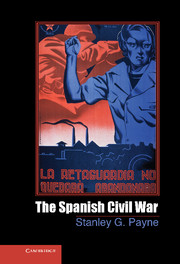Book contents
- Frontmatter
- Contents
- Chronology of Major Events
- Glossary
- Preface
- Introduction Civil War in Twentieth-Century Europe
- 1 Modernization and Conflict in Spain
- 2 From Revolutionary Insurrection to Popular Front
- 3 The Breakdown of Democracy
- 4 The Military Insurrection of the Eighteenth of July
- 5 The Battle of Madrid – the First Turning Point
- 6 Revolution
- 7 Terror
- 8 A War of Religion
- 9 Franco's Counterrevolution
- 10 Foreign Intervention and Nonintervention
- 11 Soviet Policy in Spain, 1936–1939
- 12 The Propaganda and Culture War
- 13 A Second Counterrevolution? The Power Struggle in the Republican Zone
- 14 The Decisive Northern Campaigns of 1937–1938
- 15 The War at Sea and in the Air
- 16 Civil Wars within a Civil War
- 17 The War in Perspective
- Conclusion Costs and Consequences
- Select Bibliography
- Index
- References
14 - The Decisive Northern Campaigns of 1937–1938
Published online by Cambridge University Press: 05 September 2012
- Frontmatter
- Contents
- Chronology of Major Events
- Glossary
- Preface
- Introduction Civil War in Twentieth-Century Europe
- 1 Modernization and Conflict in Spain
- 2 From Revolutionary Insurrection to Popular Front
- 3 The Breakdown of Democracy
- 4 The Military Insurrection of the Eighteenth of July
- 5 The Battle of Madrid – the First Turning Point
- 6 Revolution
- 7 Terror
- 8 A War of Religion
- 9 Franco's Counterrevolution
- 10 Foreign Intervention and Nonintervention
- 11 Soviet Policy in Spain, 1936–1939
- 12 The Propaganda and Culture War
- 13 A Second Counterrevolution? The Power Struggle in the Republican Zone
- 14 The Decisive Northern Campaigns of 1937–1938
- 15 The War at Sea and in the Air
- 16 Civil Wars within a Civil War
- 17 The War in Perspective
- Conclusion Costs and Consequences
- Select Bibliography
- Index
- References
Summary
The Spanish Civil War was the most broadly mobilized and militarily innovative of the European civil wars, and proportionate to population was fought on the largest scale. The Russian conflict lasted longer, was fought over a much greater geographic expanse, and at one time or another involved many more men and women, but, despite calling up more than 5 million men, at no time did the Soviet Red Army have more than a large fraction of them fully mobilized and ready for combat. Before the end of 1937, both armies in Spain had organized a greater percentage of their zone's population, and also had armed them better.
Nonetheless, neither contender in Spain could be compared with the armies of the major powers in the world wars. Even though more than 2 million men were called up by both sides combined, there were severe limits to training, organization, and leadership. Front lines were extremely long and offensive operations were narrowly focused, leaving most sectors quiescent. Overall, the Spanish struggle was a low-intensity conflict punctuated by a number of high-intensity battles. Despite the introduction of late-model planes and antiaircraft guns, firepower was in general limited, which explains why casualties were not higher. Not many more than 175,000 men were killed on both sides combined (some 25,000 of them not Spanish), slightly less than 6 percent of all mobilized. This was a significant figure, yet there could be no comparison with the catastrophic loss of life in the Russian civil war. Millions of Russian civilians perished because of very poor nutrition, bad sanitation, and massive epidemics; such scourges were much more effectively controlled in a West European country like Spain. Medical care on both sides was much better than in the Russian civil war, with many fewer deaths from wounds, particularly as a result of techniques pioneered in the People's Army by the radically innovative Dr. Josep Trueta, who developed new surgical procedures for puncture wounds.
- Type
- Chapter
- Information
- The Spanish Civil War , pp. 183 - 202Publisher: Cambridge University PressPrint publication year: 2012



